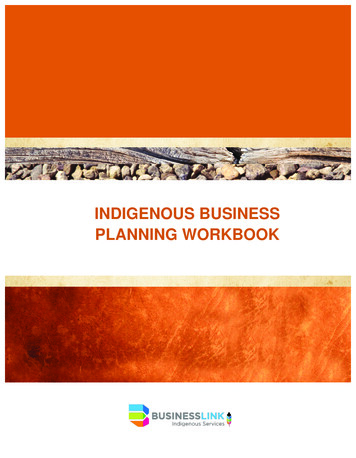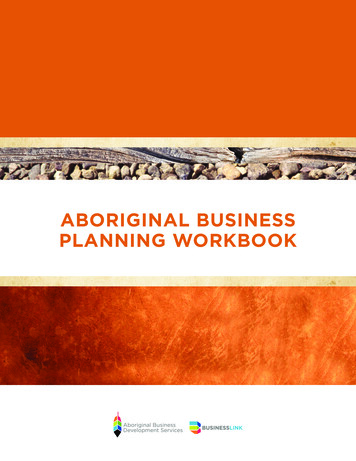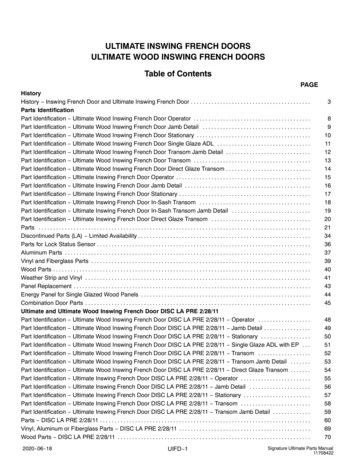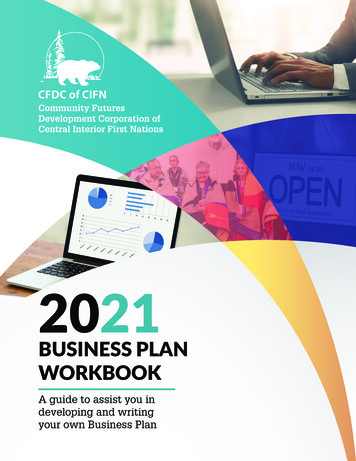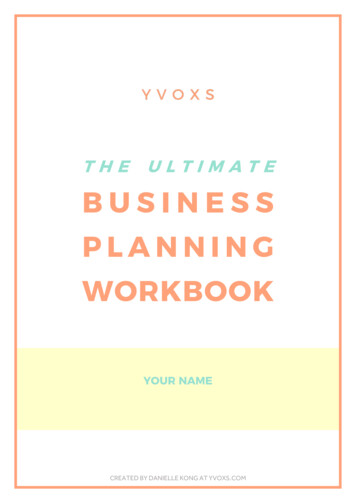
Transcription
THEULTIMATEBUSINESSPLANNINGWORKBOOKYOUR NAMECREATED BY DANIELLE KONG AT YVOXS.COM
ABOUT THIS WORKBOOKSo you want to write a business plan.You might be:- A solopreneur trying to build a business from scratch- A business professional wanting to get a better understanding ofbusiness- A consultant trying to provide better value to clients- An existing business owner re-thinking the business model- An existing business owner re-writing your business plan- Or just a smart guy or gal having a wee look at what business plans areall about.Well – first of all, welcome. And congratulations on taking this step! Businessplans can seem intimidating and so many entrepreneurs skip this step just toregret it later. But not you, my friend. Not you.Now, let me tell you what you’ll get out of this workbook.This business plan workbook is designed to help strategiesmarketPrice yourDefine yourproductsgoalsConsiderwho youneedConsider &comparecompetitorsPlan aheadfinanciallyWhen you’re done, you’ll be ready to write your full business plan!YVOXS.COM
Table of ContentsABOUT THIS WORKBOOK .2THE BUSINESS PLAN STRUCTURE .4EXECUTIVE SUMMARY.5About the Business .5About the Product.5About the Market .6About the Money.6BUSINESS DETAILS.7Registration and Structure.7The Premises .8The Team .8THE PRODUCT/SERVICE .9Products and Services .9THE MARKET . 11Market Analysis. 11Customer Analysis . 12The Competition . 15SWOT Analysis. 18Marketing Strategy . 19THE FINANCE . 22Startup Capital and Expenses . 22P&L and Cash Flow . 23GOALS AND MILESTONES. 24The Goals . 24The Milestones . 25APPENDICES . 26YVOXS.COM
SECTION 1:THE BUSINESS PLAN STRUCTUREA business plan shows your ideas and plans about your business, and how you’re planning toachieve your business goals. Whether or not you’re showing it to a potential investor orkeeping it for your eyes only, a business plan should make logical sense.As such, most business plans follow a similar structure:1. Executive SummaryThe executive summary section outlines the most important aspects of yourbusiness and what’s included in the rest of your plan. This is best written last.2. Business DetailsThis section provides information on the core components of your business,including ownership details, business structure, employees, and otheroperational details.3. The Product/ServiceThe product/service section of the business plan provides information aboutwhat you’re selling, what problems they solve and how.4. The MarketThis component of the business plan is about your current and potentialcustomers and how to reach them most effectively. Here, you’ll also identify yourcompetitors and how to stand out against them.5. The FinanceThe financial section details how much you need to set up and/or run yourbusiness, how much it’s making and how much you expect to make in the future.6. Goals and MilestonesThis section is all about the future of your business and what you hope to achieve.It details how you plan on achieving your goals and how they will be measured.7. AppendicesThroughout your business plan, you’re likely to refer to additional documents orother sources of information. This section is where you provide them.YVOXS.COM
SECTION 2:EXECUTIVE SUMMARYThe executive summary section outlines the most important aspects of your business andwhat’s included in the rest of your plan. For those seeking investors, the summary is a critical‘first impression’ page that will either intrigue the potential investors to read further orswitch off. This is best written last, after you’ve completed the rest of the business plan.About the BusinessYou’ll be able to write in more detail about your business in the next section. Here, you’llprovide a brief overview of your business.What is your business about?In the simplest way, what is your business about and what does it do? What is your missionstatement – i.e. what purpose does your business serve?About the ProductYou’ll have a chance to explain more about your product in a later section. Here, give abrief introduction about what you’re selling.What are your products or services?What is your business selling? Why is it special?YVOXS.COM
About the MarketYou’ll have a chance to explain more about your product in the marketing section. Usethis space to briefly describe your customers.Who wants your products or services?Who is your target market and how will you reach them?About the MoneyYou’ll be able to provide an in-depth overview of your finances in the finance section.Here, outline the important financial information for your business.How much money is required?How much do you need to set up/run your business and how much do you expect to make?YVOXS.COM
SECTION 3:BUSINESS DETAILSThis section provides information on the core components of your business, includingownership details, business structure, employees, and other operational details.Registration and StructureThis component of the Business Details section explains how your business is set up andstructured, and what kind of work is expected from those involved.Who’s boss?Explain who you are and what you bring to the business. If you have (or plan to have) businesspartners, explain the business structure and briefly describe your partners, theirbackgrounds and involvement as well.Who did you notify?Depending on your business model, you may have an ABN, ACN, or both. Provide anyrelevant registration details and other required license(s) for your industry or profession. Ifyou don’t have the required registrations yet, find out what you need and list them below.YVOXS.COM
The PremisesThis is where you consider the location of your business and how it can contribute to therunning of your business.Where are you?Explain where you’re located or where you plan to set up your business. Describe thepremises and area in terms of their size, surroundings, and convenience (e.g. publictransport access and parking).The TeamHere, think about who you have or need in your team and the responsibilities they mighthave. *Solopreneurs, don’t skip this section! Use this section to consider what tasks andduties may be outsourced to contractors or other systems.Who do you work with?Describe your current or future team. How many people are required and whatresponsibilities do they have? How important are they to your business? Remember, even ifyou CAN do everything yourself, knowing how to distribute work is an important skill.YVOXS.COM
SECTION 4:THE PRODUCT/SERVICEYour business will make its money by selling a product or service. As such, it’s important tothink about exactly what you’re selling and for how much, and why the product exists. Usethis section to consider your products and services in depth.Products and ServicesThis section is all about the products or services that you currently have or aredeveloping. When completing this section, consider your products from the customers’point of view.What are you selling?List your main products or services below – current and in development, and their price.Product/ServiceYVOXS.COMPrice
Why are you selling these?The products or services that you sell should ideally respond to a need or demand. Whatproblem do they solve and what need do they satisfy? In other words, what kind of value doyour products or services provide to your customers?What’s so special about them?What is unique about your products or services that your customers would choose themover others? What is the anticipated demand for them?How will they get managed?What processes are involved in the production and delivery of your products or services? Doyou need any suppliers and do you have a backup plan? How will you maintain its quality?YVOXS.COM
SECTION 5:THE MARKETThe market section of your business plan is about your current and potential customers. Itdetails your market research findings – who your customers are, where they are, wherethey buy your products and services, and what entices them to let your business solve aproblem they’re having. It also outlines your marketing targets/goals and the strategiesthat are being and will be implemented to meet those targets. This section also explainshow you plan to maintain or improve your position against the competition.Now, this might all sound quite intimidating, but don’t worry. To put it in simple terms, themarketing section of your business plan is all about knowing WHO you’re selling to.Knowing your target market allows you to direct all of your business activities TO a specificaudience. This saves time and money as you’re speaking to an audience that wants to hearfrom you, instead of exhausting your marketing budget on a broader network who may notbe interested in your products or services at all.Market AnalysisDon’t be put off by these words! Depending on your business, your market analysis mightbe as easy as a few vigorous Google searches! Here, you’ll consider the market you’retrying to enter in order for your business to survive and hopefully thrive in it.Tell me what you know about your market.Do you know how big the market is in terms of its volume and value? What drives the demandfor your products – i.e. Why are your products wanted? Are there any noticeable trends inthe market in terms of its growth and how do you think this will affect your business?YVOXS.COM
Anything you need to worry about?While some markets may stand the test of time and advancement of technology, some mayfind their position shaky in changing environments. Are there any identifiable limitations orissues in your market, and in what ways do you expect the market to fluctuate?Customer AnalysisWithin your market reside your customers. In order to communicate with and providevalue to your customers, you need to first be able to know who they are and what theywant. This allows you to grow and move with your customers and develop your businessand its products to respond to a problem that your customers want solved.Who would buy your products?Consider the type of person/group that would find your products useful and enticing. Whilewe would all like to say, “everyone would like my products!” that’s generally not the case.When trying to please everyone, you risk losing the thing that makes your business unique.There is also a balance between what you WANT to sell, and who would receive it positively.At the end of the day, you wouldn’t want to produce things that you’re not passionate about!No idea who would buy your products? Search for them using hashtags on social media, askyour friends and family, and do a few simple Google searches. Who’s talking about them andwho has reviewed them?YVOXS.COM
Who is your ideal customer?You’ve considered what type of person or group would buy your products. Now, tell me, whowould be THE perfect customer? Describe them in terms of who they are, what they’re like,what they find interesting and why they do what they do. Often, it’s a useful exercise tocreate a specific customer persona so that you can picture them in your head wheneveryou’re producing marketing or advertising materials. What’s his/her name and how old ishe/she? Describe this person below.For more guidance creating your ideal customer profile, get our FREE Ideal CustomerMarketing Strategy Workbook! From there, you can create up to 3 different customerpersonas that are print-ready so that you can stick them on your desk and refer to themwhenever necessary!How will you reach them?Now that you know who your customers are and what they’re after, consider how you canuse this information to best reach them. Think about where they spend their time – online oroffline. Will you be able to reach them more easily on Facebook and Instagram or via postersin alleyways? This is the basis of your marketing strategy that we’ll expand on later. It’s allabout taking your business to where your customers are at!YVOXS.COM
How will you keep them around?It’s true that it costs considerably more to get new customers than to retain existing ones,which means that once you’ve got your customers’ attention, you need to work on retainingthem. What kind of relationship should you have with them in order to keep them aroundwithout annoying them? How should you structure your customer support? If your businessallows for a more intimate relationship with your customers, how often should you check upon them?PHEW!Let’s take a little break here and go for a walk orsomething. You just churned through a heap ofinformation for your business.Take a look at what you’ve written so far – amazing!Grab some coffee or tea, and if you’re finding thisworkbook useful, Tweet it to the world!Sharing is caring! Click here toshare this workbook on Twitter!YVOXS.COM
Do you feel refreshed after stretching your legs?Well then, let’s continue!The CompetitionUnfortunately, your marketing strategy isn’t just about the market and customers. Youalso have to watch out for your competitors! In this section, consider your positionagainst your competition and compare the aspects of the business that may set youapart.Who are your competitors?Let’s first identify your competitors. You may already know of them but if not, try thefollowing methods to find out who they are: Search for relevant keywords on Google and see who comes up.Search hashtags on social media to find out who’s active or popular.Find relevant forums or Facebook groups and see who people are talking about.Ask friends and family if they know anyone who’s doing what you’re doing!List your top 5 competitors below.YVOXS.COM
How does your business compare?Now that you’ve identified who you’re competing against, let’s compare some of theimportant aspects of your business. This is called competitive analysis.ProductPricingComparison ComparisonYVOXS.COMPoint ofValue toDifferenceCustomer
How will you compete?Knowing what your competitors have to offer to the same market that you’re in, considerhow your business can stand out against them. We’ve talked about what makes yourbusiness unique. So, how can you emphasise your unique points so that you have acompetitive advantage? Explain your point of difference and how it will help your customersconsider you against the competition.At this point, you might be wondering just what your business brings to the table that yourcompetitors don’t. Don’t let it get you down! If everyone gave up on a business idea justbecause someone else is already doing them, then we won’t have the variety that we see inthe market. Your competitive strategy doesn’t always have to involve something that’s outof-this-world unique. It could be in the quality of the product or in your approach tocustomer service. For example, you could stand out by offering an intimate and homeycustomer relationship style, if most of your competitors have a big-company corporate feel.YVOXS.COM
SWOT AnalysisSWOT stands for Strengths, Weaknesses, Opportunities and Threats. Strengths andWeaknesses refer to positive and negative aspects that are internal to the business.Opportunities and Threats refer to positive and negative factors external to thebusiness.Considering such internal and external factors that affect your business is a critical partof your marketing strategy. This allows you to look out for positive factors that you cantake advantage of, and plan ahead to minimise impact from the negative factors. Forexample, if the stability of your business depends on an external system/software, youmay want to consider a backup plan.SWOT Analysis WorksheetList your strengths, weaknesses, opportunities and threats below. For a more detailedworksheet, grab our FREE SWOT Analysis – Categorical worksheet that allows you toconsider the SWOT points for each category of your OXS.COM
Marketing StrategyNow we’ve arrived at the final part of the marketing section! This is where we put to useall the information we have gathered so far. We know the market, the customers and thecompetition – So, knowing what we know, how will you market your business?What marketing activities will you participate in?Considering where your customers are and what they like to do/read, what kind of marketingmethods will be most effective in reaching them? The methods you choose vary significantlyon the audience you’re trying to reach. For example, if your target audience is young teensand 20-somethings, you may want to focus on building a strong social media presence. Onthe other hand, if your target audience is people in their 50s and older, you might want todevelop a brand approach that is more caring and personalised.Some effective marketing methods you can consider include: Email marketingSearch engine optimisationContent marketingSocial media marketingPosters, brochures and business cardsProfessional networkingWord-of-mouthTrade shows and exhibitionsAnd more.YVOXS.COM
How will you advertise?While a lot of us often use “marketing” and “advertising” interchangeably, advertising is justone part of the broad marketing umbrella. For example, building a strong social mediapresence is most definitely a marketing strategy, but not necessarily advertising.Below are some of the ways with which you can advertise your business and connect withyour customers: Social media advertisingEmail advertisingSearch engine advertisingPosters and brochuresRadio advertisingNewspaper advertisingTelevision advertisingAnd more.List the advertising methods you want to use below and the required or expected budget.Advertising MethodYVOXS.COMBudget
How will you sell your products or services?Once your customers know about your products through your marketing activities, how willyou sell your products and services to them – i.e. What is your sales strategy? What saleschannels are available for your business? These channels include a physical store, an onlineshop, export, wholesale and more.Outline your sales channels below and explain why you’ve chosen them as the most effectiveand sensible option for your business.AWESOME!We’re done with the marketing section. I hope yougathered some valuable information about your market,customers and competition.Feel confident about marketing your business yet?If so, Tweet it to the world and let them know howexcited you are!Sharing is caring! Click here toshare this workbook on Twitter!YVOXS.COM
SECTION 6:THE FINANCEI know, it feels like you’re ready to go out there and launch your business or implement thesenew strategies to your existing business. Well, that may be, but we still have some importantthings left to consider, like the that will allow you to get them done.This section is where we consider the money required to set up your business from scratch,continue operating your business, and how much you’ll spend to produce and market yourproducts.Startup Capital and ExpensesIf you haven’t launched your business yet, consider how much capital you need initiallyto set it up.How much money can you get and from where?Have you secured or do you expect to secure any loans? Do you have any funds from yourinvestors? Any other sources of capital? Write down how much you have or can obtain andfrom where.How much do you need?Take this moment to think about all expenses required to set up your business in terms ofthe premises, admin expenses, opening inventory, advertising and marketing, and don’tforget, working capital (amount needed for day-to-day operations).YVOXS.COM
Any assets and liabilities?A business plan generally includes a balance sheet, which shows your business’s assets andliabilities at a certain point in time. Assets include cash, accounts receivable, inventory,investments, property, and so on. Liabilities may include accounts and interests payable,wages payable, loans, mortgage, and shareholders’ equity.For a full balance sheet template, download our Excel sheet or PDF form.P&L and Cash FlowBelow are two of the most essential financial statements to consider for your business.Let’s talk about profit and loss.A profit and loss (P&L) statement summarises your revenues, cost of goods and expensesincurred in a given period – monthly, quarterly or annually. Provide expected or actual overallannual figures below. For example, how much revenue have you raised last financial (orcalendar) year or how much do you expect to raise in the coming year? How much did it costor do you expect to cost to produce the goods?For a full P&L statement template, download our profit & loss package in Excel and PDF,which includes a 12-month template as well as a 3-year template.Don’t forget about the cash flow.We won’t go into your cash flow statement here, but it’s an important component of thefinancial section of your business plan. A cash flow statement is simply a financial statementshowing the cash flows into and out of your business, normally on a monthly basis. It’simportant to update it regularly to keep on top of your current finances.You can download our full cash flow templates in Excel and PDF.YVOXS.COM
SECTION 7:GOALS AND MILESTONESWelcome to the last section of this Business Planning Workbook! (Well, kinda.)Now that you’ve laid out everything there is to know about your startup or existingbusiness and its current state, this section is where you write out your goals and milestonesto carry out the things you mentioned so far. You can consider the big-picture long-termgoals, short-term goals, as well as a more comprehensive action plan.The GoalsConsider where you want to take your business to in the future.What are your long-term goals?What does your business look like in 5 years? 10 years? 20 years? List your long-term goalsand briefly state what needs to be in place in order to meet your goals.What are your short-term goals?What does your business look like in 1 year? 6 months? 1 month? List your short-term goalsand briefly state what needs to be in place in order to meet your goals.YVOXS.COM
The MilestonesThink of milestones as the objectives that must be achieved before you can reach yourshort-term and long-term goals. For example, if your long-term goal is to sell 5,000products in a month, you may want to first tick off 500 monthly product sales, then 2,000,then 3,500.What are the milestones for your goals?Considering the goals you wrote down above, list your milestones and the expected duedate.MilestonesYVOXS.COMDue Date
SECTION 8:APPENDICESIn a real business plan, this is where you would attach all the supporting documents that youreferred to throughout the plan. Just as a practice, list below the documents you’ll need togather and prepare to include in your business plan. For more templates to use as yoursupporting documents, check out our collection of templates!YVOXS.COM
ALL DONE!Congratulations, you are now one step closer tobeing a new business owner or becoming an evenbetter one than you already are!Next step, complete your very own full business plan using theinformation you gathered in this workbook.Download ourCOMPREHENSIVE BUSINESS PLAN(WORD)WAS THIS WORKBOOK HELPFUL?Share the love! Click to share thisworkbook on Twitter!"I learnt how to writemy very own #BusinessPlanwith @YVOXS's #BusinessPlanning Workbook!http://bit.ly/2gHWOI9"YVOXS.COM
This business plan workbook is designed to help you: Define business model . Consider target market . Plan marketing strategies . Consider & compare competitors Price your products . Define your goals . Consider who you need . Plan


